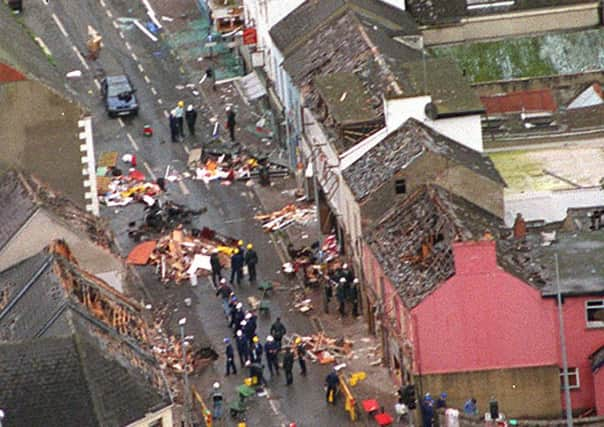How Omagh atrocity shattered fragile peace in Northern Ireland


The attack, which came four months after the signing of the historic Good Friday Agreement, was the single deadliest atrocity in the history of the Troubles.
This is a timeline of the main events leading up to and beyond the Real IRA bomb explosion, which claimed the lives of 29 people, including a woman pregnant with twins.
:: Thursday August 13 1998
Advertisement
Hide AdAdvertisement
Hide AdA red Vauxhall Cavalier - registration 91 DL 2554 - is stolen in Carrickmacross, Co Monaghan, in the Irish Republic.
:: Saturday August 15
1400 - The same car, now carrying the fake Northern Ireland registration MDZ 5211, is driven into Market Street, Omagh, and parked outside SD Kells clothes shop. Two male occupants are seen walking away in the direction of Campsie Road.
1430 - 1435: UTV and the Samaritans receive phoned bomb warnings mentioning the Omagh courthouse and “Main Street”.
1431-1510 - A police evacuation begins. There was no street named Main Street in Omagh. The courthouse is at the top of High Street, at the west end of the town. The car had actually been parked at the east end of the town, on Market Street, more than 500 yards from the court.
Advertisement
Hide AdAdvertisement
Hide AdPolice cordon off High Street and move shoppers and shop owners down to Market Street before commencing a search round the courthouse.
As a result, all the people who had been in Omagh town centre when the warning came through had now assembled in Market Street, yards from the red Cavalier. Among those gathered was a group of Spanish students who were spending the summer in Buncrana. They had gone to Omagh for the day along with a number of local children from the Co Donegal town.
1510 - A 500lb bomb packed in the Cavalier is detonated with a remote trigger. The explosion tears through Market Street. Shop fronts on both sides are blown back on top of customers still inside. Glass, masonry and metal tears through the crowd on the street as a fireball sweeps out from the epicentre.
Twenty-one people are killed instantly - some of their bodies were never found, such was the force of the blast. A water main under the road ruptures. Gallons of water gushes out. Some of the dead and badly injured are washed down the hill.
Advertisement
Hide AdAdvertisement
Hide Ad1510 - The emergency operation begins. Buses are commandeered from the nearby Ulsterbus station to help take the injured to hospital. Shelves and doors are used as makeshift stretchers. As news of the attack filters through, off-duty medical personnel head for the hospital. As well as those who died, more than 300 people are injured in the blast.
Army helicopters are scrambled to help the ambulance service ferry patients from the swamped Tyrone hospital to other medical centres.
Omagh’s leisure centre is transformed into an incident centre, with hundreds of relatives gathering there waiting for news on loved ones. A temporary morgue is set up in a British Army base in the town.
:: Sunday August 16
Relatives of those people still unaccounted for wait at the leisure centre overnight.
Advertisement
Hide AdAdvertisement
Hide Ad1200 - The identity of the 28th victim who died on the day is revealed. (Sixty-one-year Sean McGrath would die a month later from injuries suffered in the blast.)
:: An ambulance carrying one of the injured from the Erne hospital to Belfast collides with a car. The car’s driver, 38-year-old father-of-three Gary White, is killed.
The Queen, then prime minister Tony Blair, then Irish president Mary McAleese, then Irish taoiseach Bertie Ahern, then US president Bill Clinton and local politicians all voice their condemnation. Significantly Sinn Fein figures such as Gerry Adams and Martin McGuinness also condemn the attack - the first time they had unequivocally denounced a republican terrorist bombing.
:: Tuesday August 18
The Real IRA admits responsibility for the attack. The group claims its target was commercial and not civilian and blames loss of life on failure of RUC to respond to ‘’clear’’ warnings. Then Northern Ireland secretary Mo Mowlam describes the statement as ‘’a pathetic excuse for mass murder’’.
:: Saturday August 22
Advertisement
Hide AdAdvertisement
Hide AdOne week after the attack a day of reflection is held. An estimated 60,000 people gather in Omagh with thousands more attending vigils in other towns and cities across Ireland.
In Omagh, a service is conducted by church leaders on the steps of the courthouse. The event is best remembered for a moving performance by local singer Juliet Turner, whose ballad Broken Things was beamed across the world.